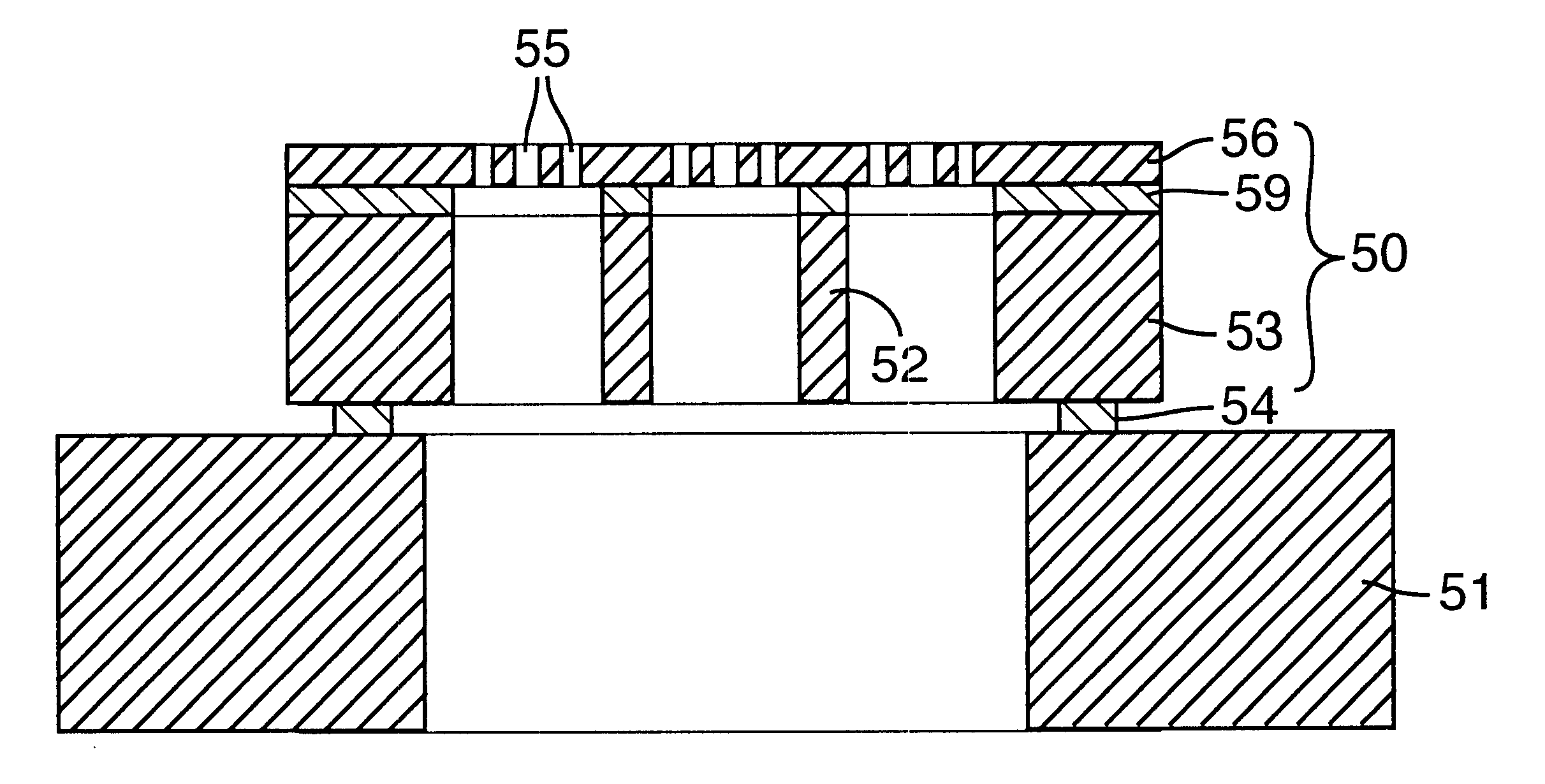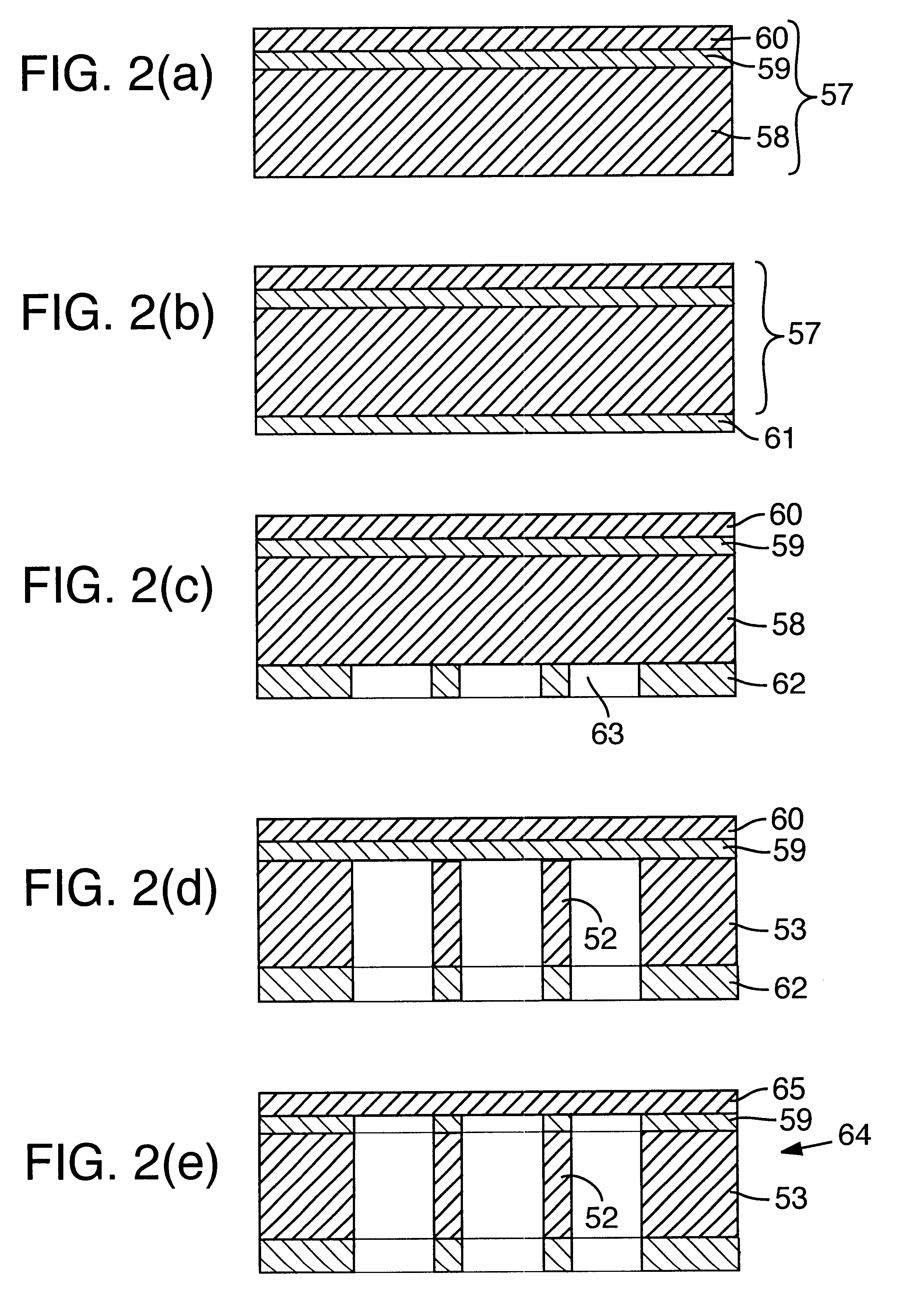Reticles including support frame for charged-particle-beam microlithography, and methods for making same
a technology of microlithography and support frame, which is applied in the direction of manufacturing tools, electric/magnetic/electromagnetic heating, instruments, etc., can solve the problems of inability to develop a practical x-ray system, the x-ray system has not yet been developed, and the resolution limitations of optical microlithography have become apparent. , to achieve the effect of reducing the stress generated in the reticle membrane 56, reducing distortion, and reducing the overall distortion of the reticle membran
- Summary
- Abstract
- Description
- Claims
- Application Information
AI Technical Summary
Benefits of technology
Problems solved by technology
Method used
Image
Examples
example 2
An SOI substrate was prepared having a diameter of 8 inches. A reticle blank was fabricated according to the process shown in FIGS. 2(a)-2(e).
A silicon support frame was fabricated having an OD of 230 mm, an ID of 190 mm, and an axial thickness of 6 mm. A glass member (Corning 7740 Pyrex.TM.) was fabricated having an OD of 200 mm, an ID of 190 mm, and an axial thickness of 1 mm. The support frame and glass member were bonded together by anodic welding at 350.degree. C. and 700 Vdc according to the process shown in FIGS. 4(a)-4(c). After bonding, the glass was ground down to a thickness of 20 .mu.m. Regions of the glass were removed by honing, wet etching, milling, etc., leaving three small glass regions, each having a surface area of "several" (no more than 5) mm square, on the silicon support frame. The support frame and the peripheral frame were then bonded together via the glass regions by anodic welding.
After bonding, a pattern of voids was formed in the reticle membrane accordi...
second representative embodiment
A reticle 80 according to this embodiment is shown in FIG. 5(a). The reticle 80 comprises a reticle portion 81 and support frame 82. The reticle portion 81 comprises a reticle membrane 83, struts 84, and a peripheral frame 85. The peripheral frame 85 is made of the silicon from which the struts 84 of the reticle 81 are made. The support frame 82 also is made of silicon. The support frame 82 is bonded to the reticle portion 81 by a eutectic bond involving a gold film 86. Between the reticle membrane 83 and the struts 84 and peripheral frame 85 is a silicon oxide layer 87.
Eutectic bonding is sufficient if the thickness of the gold film 86 is less than 2000 nm (e.g., approximately 200 nm). The gold film 86 desirably is not more than 2000 nm thick; otherwise, distortion at the eutectic bond is excessive.
The CPB microlithography reticle 80 may be either a scattering-stencil reticle or a scattering-membrane reticle. For simplicity, in the following discussion, the reticle 80 is referred t...
third representative embodiment
This embodiment is depicted in FIG. 5(b). In this embodiment, a CPB microlithography reticle 100 comprises a reticle portion 101 and a support frame 102. The reticle portion 101 comprises a reticle membrane 103, struts 104, and a peripheral frame 105. The silicon peripheral frame 105 is bonded to the silicon support frame 102 by a eutectic gold-silicon bond at their boundary surfaces via a chrome or nichrome film 106 and a gold film 107. Between the reticle membrane 103 and peripheral frame 105 is a silicon oxide layer 108.
Desirably, the chrome or nichrome film 106 has a thickness of 1 nm to 5 nm, and the gold film 107 has a thickness of 200 nm to 500 nm.
The gold film 107 can be formed by vacuum deposition or other suitable technique directly on an axial end of the support frame 102. However, a stronger and more stable gold film 107 can be achieved by first forming the chrome or nichrome film 106 directly on an axial end of A the support frame 102, followed by formation of the gold ...
PUM
| Property | Measurement | Unit |
|---|---|---|
| Thickness | aaaaa | aaaaa |
| Thickness | aaaaa | aaaaa |
| Thickness | aaaaa | aaaaa |
Abstract
Description
Claims
Application Information
 Login to View More
Login to View More - R&D
- Intellectual Property
- Life Sciences
- Materials
- Tech Scout
- Unparalleled Data Quality
- Higher Quality Content
- 60% Fewer Hallucinations
Browse by: Latest US Patents, China's latest patents, Technical Efficacy Thesaurus, Application Domain, Technology Topic, Popular Technical Reports.
© 2025 PatSnap. All rights reserved.Legal|Privacy policy|Modern Slavery Act Transparency Statement|Sitemap|About US| Contact US: help@patsnap.com



